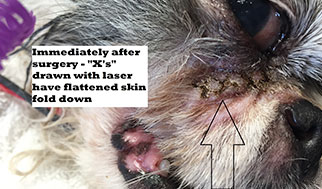Non-Invasive Laser Surgery Procedures
The surgical laser has a couple of unique properties that lend themselves to more than just cutting:
- Evaporation of Tissue – the laser cuts by vaporizing the tiny amount of tissue the beam focuses on, and letting the heat energy evaporate away in the steam plume.
- Coagulation of proteins – protein strands directly affected by the laser clot together, making them contract and pull tight.


This means that with the laser, we can do things that a regular blade-based surgery can not:
- Remove small skin masses with no stitches – the regular way to remove a skin mass is to cut out the piece of skin that contains it, and then sew the cut edges back together. With the laser, we can do Ablation instead – vapourizing layer after layer of the mass until we expose the healthy tissue underneath. If the masses are in a suitable location, this could be done with just freezing and light sedation, instead of full anaesthetic.
- Remove skin masses from places where you can NOT cut and sew – some masses do not lend themselves to being sliced out. Growths in ear canals, or over tight skin areas such as the point of a heel, are very hard to treat traditionally. Laser ablation is a better option for sites like these.
- Re-shape tissues without cutting – since the laser makes tissue contract, it can be used to reduce skin folds that cause irritation; for example, a facial cheek fold that always impinges on and irritates the eyeball.

